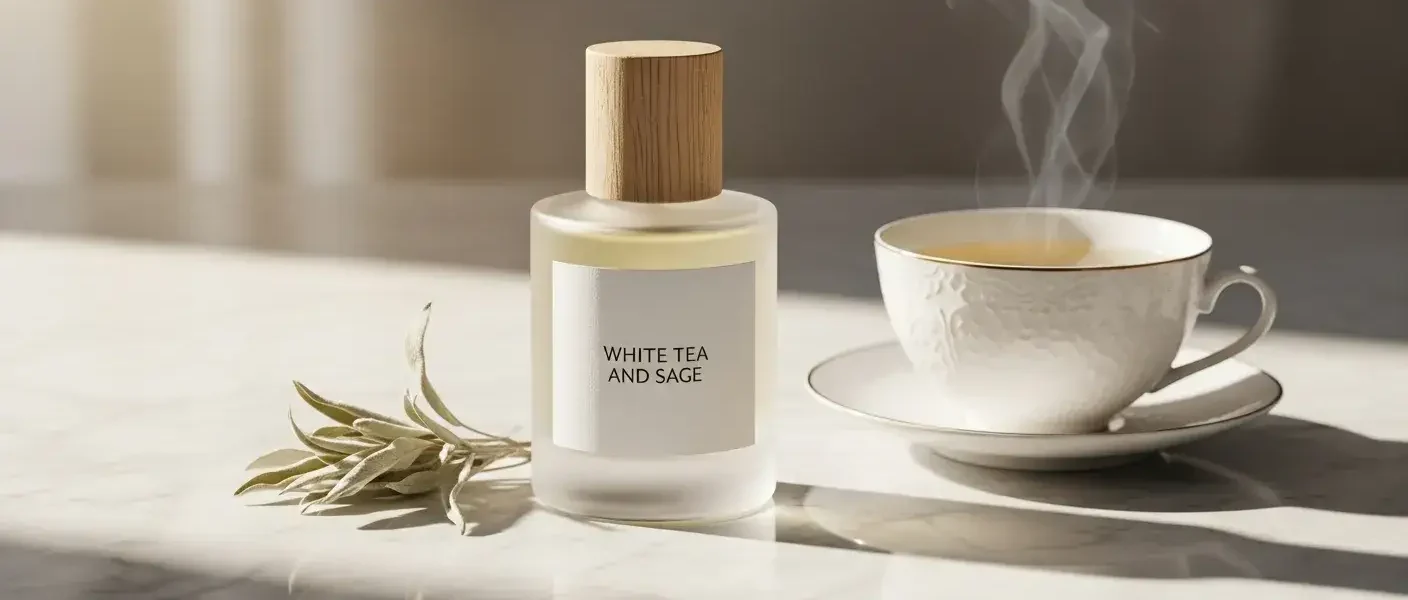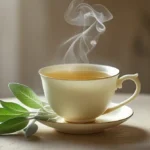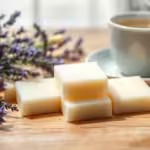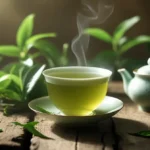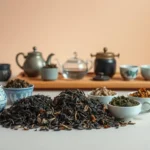Table of Contents
Have you ever caught a whiff of a perfume and just felt… calm? That’s often the magic of scents like white tea and sage perfume. It’s a combo that sounds simple, but it really brings something special to the table. We’re talking about a fragrance that feels both clean and grounded, kind of like a deep breath of fresh air mixed with a cozy herbal hug. Let’s explore what makes this particular blend so unique and why it seems to be popping up everywhere.
Key Takeaways
- Sage has a long history, used for centuries in medicine and cooking, and even traded by the Chinese for their own tea.
- White tea and sage perfume often features bright top notes like bergamot, a heart of tea and herbs, and a calming woody base.
- Different types of sage, like white, clary, and bergamot sage, bring distinct qualities to a scent, from mood enhancement to stress reduction.
- The appeal of white tea and sage fragrances comes from their balanced mix, creating a clean, airy, and tranquil scent profile.
- Creating these unique perfumes involves careful scent composition, blending herbal notes with other elements to achieve a harmonious and lasting aroma.
The Aromatic Allure Of Sage In Perfumery

A Brief Overview Of Sage
Sage, a plant with a rich past, originally hails from the Mediterranean region. It’s part of the mint family, alongside familiar herbs like rosemary and lavender. The name ‘Salvia’ comes from a Latin word meaning ‘to save,’ hinting at its long-held reputation for usefulness. For ages, sage has been recognized for both its medicinal and culinary qualities. Before modern medicine, it was a go-to herb for various health concerns.
Even ancient cultures traded valuable goods for it, recognizing its potent properties. In perfumery, sage brings a unique energy, adding a fresh, spicy, and slightly woody character that works well in both men’s and women’s scents. It’s a key ingredient for creating those aromatic herbal scents that feel both grounding and invigorating.
The Three Variations Of Sage Used In Perfumery
While there are hundreds of sage varieties, perfumers typically work with three main types to capture its distinct aroma: White Sage, Clary Sage, and Bergamot Sage. Each offers a slightly different nuance to the final fragrance.
- White Sage: Known for its clean, bright, and earthy scent, often associated with clarity and mood enhancement.
- Clary Sage: This variety has a sweeter, more herbaceous profile with musky undertones, lending a calming and lingering quality.
- Bergamot Sage: As the name suggests, it carries a hint of citrusy sweetness from bergamot, making it particularly good for stress reduction.
Historical Significance Of Sage
Sage’s history is deeply intertwined with human culture and well-being. Ancient civilizations believed it held significant healing powers and promoted wisdom. It was even thought to ward off evil spirits and was a staple in medicinal practices for centuries. This long-standing association with health and purity makes it a compelling choice for modern natural botanical perfumes and natural aroma diffuser blends, connecting wearers to an ancient legacy of natural wellness. The herbal sage fragrance has truly stood the test of time.
Unpacking The Notes Of White Tea And Sage Perfume

When you first spritz a white tea and sage perfume, you’re met with an immediate impression that sets the tone for the entire experience. These aren’t just random scents; they’re carefully chosen to create a specific feeling. Think of it like a well-composed piece of music, where each note plays a part.
Top Notes: A Bright And Invigorating Introduction
The opening act of a white tea and sage fragrance is all about that initial burst. It’s designed to grab your attention and make you feel refreshed. Often, you’ll find bright, zesty elements here. These could be citrusy notes like bergamot or lime, giving it a lively kick. Sometimes, you’ll even get a hint of something slightly aquatic or green, like sea notes or fern, which really amplifies that clean feeling. The goal is to create an immediate sense of clarity and upliftment. It’s that first breath of fresh air that makes you feel awake and ready for anything.
Heart Notes: A Soothing Herbal Complexity
As the initial sparkle fades, the perfume settles into its core, the heart notes. This is where the real magic of the white tea and sage blend often happens. You’ll find the delicate, slightly grassy aromatic white tea notes here, mingling with the earthy, herbaceous character of sage. It’s not just one type of sage, either; different varieties bring their own nuances. Sometimes, you might detect other complementary herbs like rosemary or mint, adding layers of cool, green complexity. This part of the fragrance is about creating a sense of calm and balance, a gentle herbal embrace that feels both grounding and sophisticated. It’s a beautiful interplay that defines the unique character of these fragrance notes white tea sage.
Base Notes: A Grounding And Calming Finish
Finally, the perfume settles into its base notes, the foundation that lingers on your skin. This is where the scent becomes warm, comforting, and deeply calming. You’ll often find soft woods, like cedarwood, or a gentle musk that adds a smooth, sensual finish. Sometimes, there’s a touch of amber or even something like ambrette, which gives it a subtle, skin-like warmth. These notes provide a sense of closure, leaving you with a clean, serene aura that lasts.
It’s the quiet hum after the main melody, a peaceful conclusion that makes the whole fragrance feel complete and utterly wearable. The combination of these botanical perfume notes creates a scent that is both invigorating and deeply relaxing, a true testament to the art of perfumery. For a classic example, consider the composition of Elizabeth Arden’s White Tea, which features a base of exotic woods and ambrette.
👉 Unlock the Powerful Aroma of White Tea and Sage 👈
Exploring The Unique Qualities Of Sage Varieties

When we talk about white tea and sage perfumes, it’s not just one kind of sage we’re dealing with. Different types of sage bring their own special something to the mix, making each fragrance a bit different. It’s pretty cool how one herb can have so many personalities.
White Sage: Mood Enhancement and Clarity
White sage is often thought of for its cleansing properties, and in perfumery, it brings a bright, earthy vibe. It’s not just about smelling nice; people associate it with helping to clear the mind and lift your mood. Think of it as a gentle nudge towards feeling more focused and calm. It pairs really well with other herbal notes or even light florals, creating a scent that feels both grounding and uplifting.
Clary Sage: Tranquility and Lingering Aroma
Clary sage is a bit different. It has a softer, more herbal scent with a hint of sweetness and musk. This makes it fantastic for creating a sense of peace and quiet. One of its best qualities is how it helps a fragrance last longer on the skin. So, if you want a scent that stays with you throughout the day, clary sage is a key player. It’s often found in perfumes that aim for a balanced, unisex feel.
Bergamot Sage: Stress Reduction and Sweetness
Then there’s bergamot sage. As the name suggests, it has a touch of bergamot’s citrusy brightness, making it sweeter than the other varieties. This particular sage is known for its stress-reducing qualities. The aroma is comforting and slightly uplifting, making it a popular choice for products designed to help you unwind. It adds a lovely, gentle sweetness that doesn’t overpower but rather rounds out a fragrance beautifully.
The Enduring Appeal Of White Tea And Sage Fragrances

A Harmonious Blend Of Florals And Herbs
There’s something really special about how white tea and sage come together in a perfume. It’s not just a simple mix; it’s a carefully put-together scent that feels both familiar and new. Think of it like a perfectly brewed cup of herbal tea fragrance, but for your skin. The white tea brings this clean, slightly delicate aroma, almost like a soft whisper.
Then, the sage steps in, adding this grounding, herbal depth that stops it from being too light. It’s this balance that makes it so appealing. You get the freshness from the tea and the comforting, earthy notes from the sage, and they just play off each other so nicely. It’s a combination that feels sophisticated without trying too hard.
Evoking Tranquility And Balance
This scent profile really taps into a feeling of calm. When you wear a white tea and sage fragrance, it’s like you’re creating a little bubble of peace around yourself. The sage, in particular, has this way of making you feel more centered. It’s often associated with clarity and a sense of well-being, and that translates directly into the perfume. It’s not an overpowering scent; it’s more subtle, which is perfect for everyday wear or when you just want to feel a bit more serene. It’s the kind of fragrance that helps you take a deep breath and just be present. It’s a gentle reminder to slow down.
A Clean, Airy Scent Profile
What really sets white tea and sage apart is its clean and airy quality. It avoids being heavy or cloying, which is a big plus for many people. Instead, it offers these earthy and clean scents that feel light and refreshing. It’s like stepping out into a crisp morning or walking through a garden after a light rain. The notes are distinct but blend together to create an overall impression of purity and simplicity. It’s a fragrance that doesn’t demand attention but rather draws people in with its understated elegance. It’s the kind of scent that just feels good to wear, leaving you feeling refreshed and put-together.
Here’s a quick look at what makes up this appealing profile:
- White Tea: Provides a delicate, slightly sweet, and clean opening.
- Sage: Adds an herbal, grounding, and subtly earthy middle note.
- Supporting Notes: Often includes light florals, subtle woods, or hints of citrus to round out the fragrance.
This scent combination is a masterclass in understated perfumery. It proves that you don’t need a complex, heavy aroma to make a lasting impression. The simplicity is its strength, offering a sophisticated and comforting experience that feels both modern and timeless. It’s a fragrance that speaks to a desire for balance and natural well-being, making it a popular choice for those seeking a scent that is both refreshing and grounding. You can find beautiful examples of this scent profile in many modern fragrance creation lines.
👉 Experience the Exclusive Premium White Tea and Sage Fragrance 👈
Crafting Unique White Tea And Sage Perfume
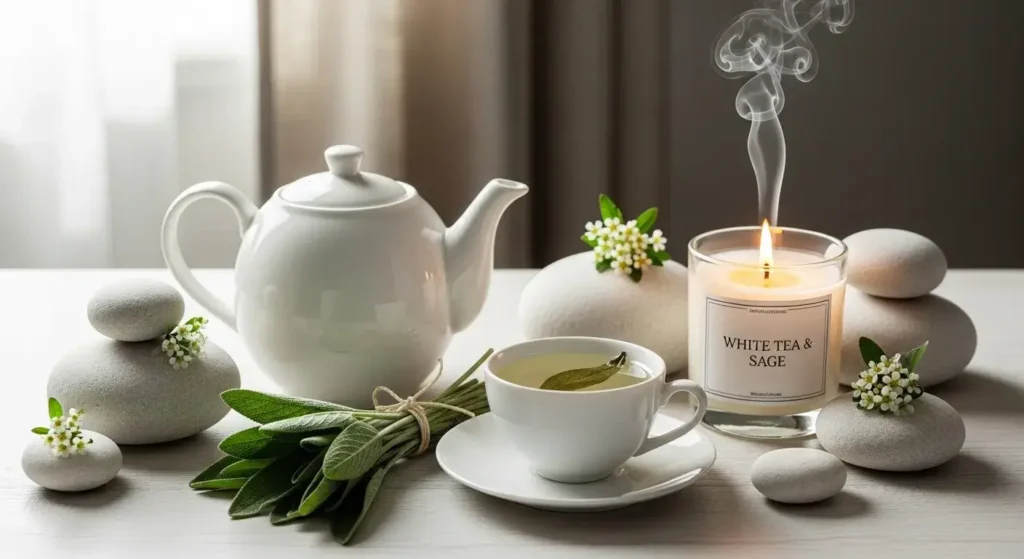
The Art Of Scent Composition
Creating a truly unique white tea and sage perfume is a delicate dance between nature’s own aromatic gifts. It’s not just about throwing a few scents together; it’s about understanding how each note plays with the others. Think of it like composing a piece of music, where each ingredient is an instrument, and the perfumer is the conductor. The goal is to harmonize the delicate white tea scent with the earthy, sometimes peppery, notes of sage. This often involves layering different types of sage, like the mood-enhancing white sage or the tranquil clary sage, with the clean, bright essence of white tea. The result? Calming herbal perfumes that feel both familiar and entirely new.
Expertise In Fragrance Creation
When you’re aiming for something special, like a unique botanical cologne, you need skilled hands guiding the process. Perfumers use a range of techniques and a deep knowledge of raw materials to achieve specific effects. For instance, capturing that elusive, calming tea based perfumes aroma requires careful selection and blending. They might use headspace analysis to understand the exact aromatic profile of a particular white tea or sage variety, then recreate or enhance it. This meticulous approach is what separates a generic scent from a signature fragrance. It’s about understanding the nuances that make calming tea based perfumes so appealing.
Showcasing Modern Brands
Many contemporary brands are exploring the potential of white tea and sage. They’re moving beyond traditional fragrance structures to create scents that speak to a modern desire for balance and well-being. You’ll find these notes appearing in everything from fine perfumes to home diffusers. The appeal lies in their versatility; they can be both refreshing and grounding. These brands are really showing how herbal tea scented fragrance can be sophisticated and widely loved. It’s exciting to see how these natural elements are being reinterpreted for today’s market, offering a clean, serene olfactory experience. If you’re interested in exploring DIY scent creation, there are many resources available, like essential oil recipes.
The magic happens when the subtle, almost ethereal scent of white tea meets the robust, grounding aroma of sage. It’s a contrast that creates a beautiful tension, resulting in a fragrance that is both invigorating and deeply calming. This blend taps into a desire for natural, uncomplicated scents that still possess a sophisticated edge.
Here’s a look at how the notes might come together:
- Top Notes: Often a bright opening with hints of bergamot or citrus to lift the senses.
- Heart Notes: The core of the fragrance, where the white tea and sage notes truly shine, perhaps with added herbal touches like rosemary or lavender.
- Base Notes: A grounding finish, usually with soft woods, musk, or amber to provide longevity and depth.
The Enduring Legacy Of Sage In Fragrance
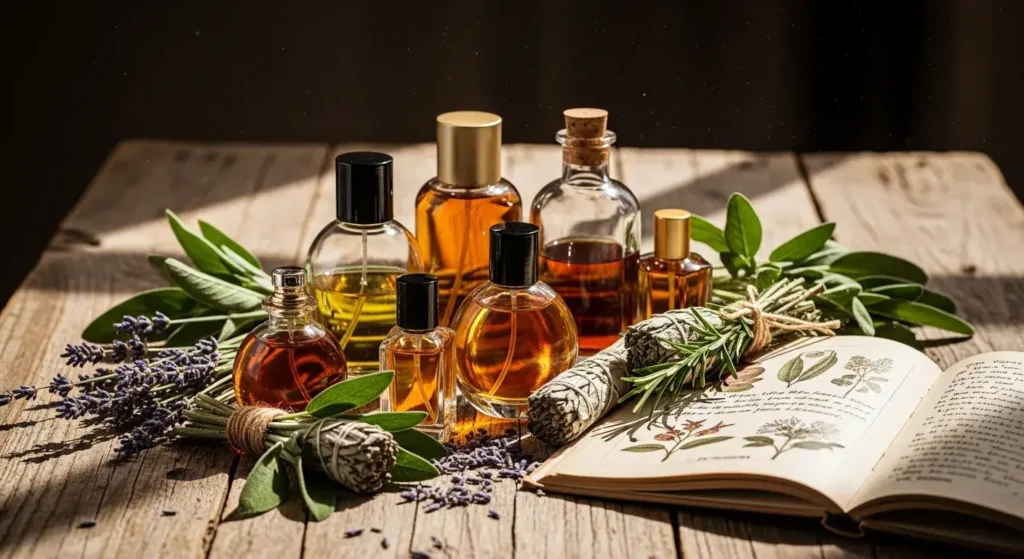
Sage isn’t just a kitchen herb; it’s got a seriously long history in the world of scent. For ages, people have recognized its power, not just for cooking or medicine, but for its aroma too. It’s this deep connection to history and nature that makes sage so special in perfumes, especially when paired with something as delicate as white tea. We’re talking about botanical inspired fragrances that feel both ancient and totally modern.
Sage As A Symbol Of Health And Wisdom
Think back to ancient times. Sage was seen as more than just a plant; it was linked to good health and sharp minds. The name itself, ‘Salvia’, comes from the Latin word for ‘to save’, hinting at its perceived healing powers. It was believed to boost memory and promote wisdom, making it a go-to for important ceremonies or learning. This historical weight adds a certain gravitas to any fragrance that uses it.
Ancient Beliefs And Modern Applications
Across different cultures, sage held a sacred status. Native American tribes used it in rituals to clear negative energy, burning it in smudge sticks. The Romans thought it was great for digestion and healing. Even Charlemagne ordered it planted on imperial farms because of its value in medicine and trade. Today, these ancient beliefs translate into clean earthy fragrances that offer a sense of purification and well-being. It’s fascinating how these old ideas still influence the unique scent profiles we enjoy now.
Sage’s Role In Prosperity
It’s not all about health and wisdom; sage was also tied to good fortune. In medieval England, the health of sage plants in a garden was thought to reflect the success of a business. More sage meant prosperity, less meant trouble. This connection to abundance and growth adds another layer to its appeal in sage infused scent creations. It’s like wearing a little bit of good luck.
Here’s a quick look at how different sage varieties contribute:
- White Sage: Known for its mood-lifting and clarifying properties, it brings a bright, earthy note.
- Clary Sage: Offers a more tranquil, musky aroma that helps fragrances last longer.
- Bergamot Sage: Adds a touch of sweetness and is recognized for its stress-reducing qualities.
The way sage weaves its way through history, from ancient rituals to modern perfumery, is pretty remarkable. It brings a natural, grounding element that balances beautifully with lighter notes, creating scents that feel both comforting and invigorating. It’s this blend of history, nature, and perceived well-being that makes sage a timeless ingredient in the art of fragrance.
Wrapping It Up
So, when you catch that whiff of white tea and sage, remember it’s more than just a nice smell. It’s a mix of history, nature, and a bit of clever blending. That clean, herbal scent comes from sage, an herb people have used for ages for everything from medicine to just making things smell good. Then you’ve got white tea, adding that light, fresh feeling. Together, they create something that feels both calming and a little bit energizing, which is pretty neat. It’s a scent that’s both familiar and unique, making it a go-to for lots of different products, and it’s easy to see why people keep coming back to it.
👉 Elevate Your Scent with Revolutionary White Tea and Sage 👈
Frequently Asked Questions
What is sage and why is it used in perfumes?
Sage is a fragrant herb that comes from the Mediterranean. It’s related to mint and has been used for a long time for its smell and health benefits. In perfumes, sage adds a fresh, slightly spicy, and woody scent that can make a fragrance feel more energetic.
What are the main types of sage used in perfumes?
There are many kinds of sage, but perfumers usually use three main types: Clary Sage, which smells sweet and musky and helps scents last longer; White Sage, which is earthy and uplifting; and Bergamot Sage, which is a bit sweeter and known for helping people feel less stressed.
What does a white tea and sage perfume smell like?
White tea and sage perfumes often start with a bright, clean scent from the white tea and maybe some citrus. Then, the herbal notes of sage come through, sometimes mixed with other herbs like rosemary or mint. The smell usually finishes with a calm, woody, or musky scent that feels grounding.
What makes white tea and sage scents special?
These scents are special because they blend the clean, light aroma of white tea with the unique, herbal fragrance of sage. This combination creates a balanced smell that is both refreshing and calming, like a peaceful moment in nature.
Are there different ways to experience white tea and sage scents?
Yes, you can find white tea and sage scents in various forms like Eau de Parfum sprays, which are long-lasting, or perfume oils that are very concentrated. They are also sometimes used in candles and other home fragrance products.
What is the history behind using sage in scents?
Sage has a rich history. Ancient people believed it had healing powers and could bring wisdom. Some cultures even thought it could protect against bad spirits. This long-standing appreciation for sage’s qualities makes it a popular ingredient in modern fragrances.
